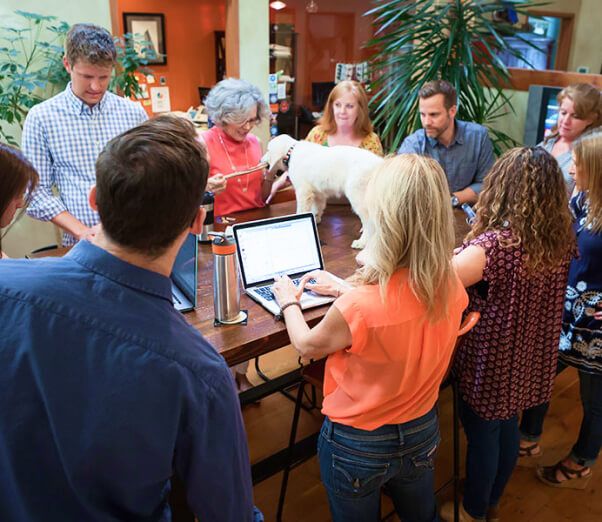Using brand laddering to improve social media engagement
Why does someone love your product or brand? It’s probably not because it comes in pink. One way to find the answer to that question is through a process called brand laddering.
If you’re not familiar with brand Laddering it’s a way of identifying the personal and societal values people hold that a product or brand connects to. Big brands spend a lot of time and money on qualitative interviews to get this information. For smaller brands or nonprofits, going through the full process might not be possible, but it’s still worth doing some small scale brand laddering, even as a thought exercise. Even big brands can’t conduct complete brand laddering exercises for every social post they do, but any brand big or small can apply the concepts of brand laddering to something as common as social media posts.
I’ll talk briefly about each rung on the brand ladder and combine it with examples of how you can apply the concepts to your social media posts. The ultimate goal is to achieve greater social media engagement by using this structure to frame your posts.
The Brand Ladder
At a very basic level, the brand ladder can be broken down into three rungs.
- Attributes
- Functional benefits
- Values
Other versions of the model include more rungs, which are worth exploring, but for the purposes of this blog post, I’ll keep things basic.
1. Attributes
The attributes of something are the surface level components. You could say your product, such as a soda, includes natural ingredients, is only 50 calories, is blue, etc. This is often what people and marketers talk about when they begin a discussion about a product.
 Market Researcher: “Why do you like this?”
Consumer: “It’s 50 calories”
If you’re focusing your social media post on this level of information, it’s fine but you may see lower engagement since you’re not giving people something to latch onto or connect with.
Sure you’ll get some people to like a post focused on attributes if they already love your brand or have been waiting for your blue soda, but it’s not likely to go viral.
Market Researcher: “Why do you like this?”
Consumer: “It’s 50 calories”
If you’re focusing your social media post on this level of information, it’s fine but you may see lower engagement since you’re not giving people something to latch onto or connect with.
Sure you’ll get some people to like a post focused on attributes if they already love your brand or have been waiting for your blue soda, but it’s not likely to go viral.
2. Functional benefits
This is also sometimes called rational benefits. It gets at the reason the features or attributes matter to a person on a rational level.
 This is also sometimes called rational benefits. It gets at the reason the features or attributes matter to a person on a rational level.
Market Researcher: “Why do you like that it’s 50 calories?”
Consumer: “It makes my diet easier.”
Moving to the second rung of the ladder gets a little deeper into the reasons somebody might care about your brand or product. Focusing a social media post at this level should get you a little more engagement. People can start to identify with a shared need. Also, and this is key, focusing on functional benefits allows you to start focusing more on the consumer, rather than your product or brand.
This is also sometimes called rational benefits. It gets at the reason the features or attributes matter to a person on a rational level.
Market Researcher: “Why do you like that it’s 50 calories?”
Consumer: “It makes my diet easier.”
Moving to the second rung of the ladder gets a little deeper into the reasons somebody might care about your brand or product. Focusing a social media post at this level should get you a little more engagement. People can start to identify with a shared need. Also, and this is key, focusing on functional benefits allows you to start focusing more on the consumer, rather than your product or brand.
3. Values
This is also called emotional or social benefit. It’s that final level of emotional connection. This matters because humans are inherently emotional decision makers, not purely rational beings. Psychologists have shown that people are more moved to decisions and action by emotion than facts and data. How often have you reacted to something because of the way you feel? That’s what we’re trying to tap into in social media, you have a split second to make someone feel enough of an emotion to stop and move their thumb to that like button, or even better, share it or make a comment. You may not be able to conduct qualitative interviews about every social post, but hopefully you know your audience well enough to go through the thought experiment of digging down to the value, whether it’s an emotional one or a social value that allows them to FEEL something about what you’re saying.
Market researcher: “Why does it matter that it makes your diet easier?”
Consumer: “Dieting is hard, but if I’m successful I’ll feel more comfortable in my body.”
 At this level, you’re connecting with people on a level where they’re going to start lingering on your social media content, maybe they’ll hover long enough to absorb your message and identify with it or engage. Those feelings (hopefully positive) will start to become associated with your brand.
Without conducting brand laddering interviews for every social post, you can still think through each rung of the ladder by asking yourself why your content matters to your audience. What emotional connection might someone have with the content you’re posting? Make that the focus of your post and more often than not, you’ll start seeing engagement numbers increase.
If that doesn’t work, puppies are always a great emotional shortcut.
At this level, you’re connecting with people on a level where they’re going to start lingering on your social media content, maybe they’ll hover long enough to absorb your message and identify with it or engage. Those feelings (hopefully positive) will start to become associated with your brand.
Without conducting brand laddering interviews for every social post, you can still think through each rung of the ladder by asking yourself why your content matters to your audience. What emotional connection might someone have with the content you’re posting? Make that the focus of your post and more often than not, you’ll start seeing engagement numbers increase.
If that doesn’t work, puppies are always a great emotional shortcut.
 Market Researcher: “Why do you like this?”
Consumer: “It’s 50 calories”
If you’re focusing your social media post on this level of information, it’s fine but you may see lower engagement since you’re not giving people something to latch onto or connect with.
Sure you’ll get some people to like a post focused on attributes if they already love your brand or have been waiting for your blue soda, but it’s not likely to go viral.
Market Researcher: “Why do you like this?”
Consumer: “It’s 50 calories”
If you’re focusing your social media post on this level of information, it’s fine but you may see lower engagement since you’re not giving people something to latch onto or connect with.
Sure you’ll get some people to like a post focused on attributes if they already love your brand or have been waiting for your blue soda, but it’s not likely to go viral.
 This is also sometimes called rational benefits. It gets at the reason the features or attributes matter to a person on a rational level.
Market Researcher: “Why do you like that it’s 50 calories?”
Consumer: “It makes my diet easier.”
Moving to the second rung of the ladder gets a little deeper into the reasons somebody might care about your brand or product. Focusing a social media post at this level should get you a little more engagement. People can start to identify with a shared need. Also, and this is key, focusing on functional benefits allows you to start focusing more on the consumer, rather than your product or brand.
This is also sometimes called rational benefits. It gets at the reason the features or attributes matter to a person on a rational level.
Market Researcher: “Why do you like that it’s 50 calories?”
Consumer: “It makes my diet easier.”
Moving to the second rung of the ladder gets a little deeper into the reasons somebody might care about your brand or product. Focusing a social media post at this level should get you a little more engagement. People can start to identify with a shared need. Also, and this is key, focusing on functional benefits allows you to start focusing more on the consumer, rather than your product or brand.
 At this level, you’re connecting with people on a level where they’re going to start lingering on your social media content, maybe they’ll hover long enough to absorb your message and identify with it or engage. Those feelings (hopefully positive) will start to become associated with your brand.
Without conducting brand laddering interviews for every social post, you can still think through each rung of the ladder by asking yourself why your content matters to your audience. What emotional connection might someone have with the content you’re posting? Make that the focus of your post and more often than not, you’ll start seeing engagement numbers increase.
If that doesn’t work, puppies are always a great emotional shortcut.
At this level, you’re connecting with people on a level where they’re going to start lingering on your social media content, maybe they’ll hover long enough to absorb your message and identify with it or engage. Those feelings (hopefully positive) will start to become associated with your brand.
Without conducting brand laddering interviews for every social post, you can still think through each rung of the ladder by asking yourself why your content matters to your audience. What emotional connection might someone have with the content you’re posting? Make that the focus of your post and more often than not, you’ll start seeing engagement numbers increase.
If that doesn’t work, puppies are always a great emotional shortcut.



